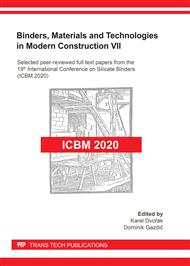[1]
Mineral commodity summaries 2020, U.S. Geological Survey, Reston, VA, (2020).
Google Scholar
[2]
IAEA, Radiation Protection and Management of NORM Residues in the Phosphate Industry, Safety Reports Series No. 78, International Atomic Energy Agency (IAEA), Vienna, (2013).
DOI: 10.1088/0952-4746/33/2/b01
Google Scholar
[3]
A.M. Rashad, Phosphogypsum as a construction material, Journal of Cleaner Production 166 (2017) 732-743.
DOI: 10.1016/j.jclepro.2017.08.049
Google Scholar
[4]
A. Sarkka, Disposal management system for utilisation of industrial phosphogypsum and fly ash, in: Life Environment in Action: 56 New Success Stories for Europe´s Environment, Office for Official Publications of the European Communities, Luxembourg, 2001, pp.98-99.
Google Scholar
[5]
W.F. Chang, D.A. Chin & R. Ho, Phosphogypsum for secondary road construction, Florida Institute of Phosphate Research, Bartow, Florida, (1989).
Google Scholar
[6]
S. Folek, B. Walawska, B. Wilczek & J. Miśkiewicz, Use of phosphogypsum in road construction, Polish journal of chemical technology 13 (2011) 18-22.
DOI: 10.2478/v10026-011-0018-5
Google Scholar
[7]
P. Paige-Green & S. Gerber, An evaluation of the use of by-product phosphogypsum as a pavement material for roads, SATC Action in Transport for the New Millennium, (2000).
Google Scholar
[8]
N. Degirmenci, A. Okucu & A. Turabi, Application of phosphogypsum in soil stabilization, Building and Environment 42 (2007) 3393-3398.
DOI: 10.1016/j.buildenv.2006.08.010
Google Scholar
[9]
C. Gascó et al., Advantages and disadvantages of using phosphogypsum as building material radiological aspects, Proceedings of the 1st National Spanish Conference on Advances in Materials Recycling and Eco-Energy (RECIMAT'09), Madrid, Spain (2009) 83-86.
Google Scholar
[10]
J. Yang, W. Liu, L. Zhang & B. Xiao, Preparation of load-bearing building materials from autoclaved phosphogypsum, Construction and Building Materials 23 (2009) 687-693.
DOI: 10.1016/j.conbuildmat.2008.02.011
Google Scholar
[11]
M. Zieliński, Influence of constant magnetic field on the properties of waste phosphogypsum and fly ash composites, Construction and Building Materials 89 (2015) 13-24.
DOI: 10.1016/j.conbuildmat.2015.04.029
Google Scholar
[12]
S. Hua, K. Wang, X. Yao, W. Xu & Y. He, Effects of fibers on mechanical properties and freeze-thaw resistance of phosphogypsum-slag based cementitious materials, Construction and Building Materials 121 (2016) 290-299.
DOI: 10.1016/j.conbuildmat.2016.06.003
Google Scholar
[13]
J. Zhou et al., A novel Two-step Hydration Process of preparing cement-free non-fired bricks from waste phosphogypsum, Construction and Building Materials 73 (2014) 222-228.
DOI: 10.1016/j.conbuildmat.2014.09.075
Google Scholar
[14]
J. Zhou et al., Preparation of hardened tiles from waste phosphogypsum by a new intermittent pressing hydration, Ceramics International 42 (2016) 7237-7245.
DOI: 10.1016/j.ceramint.2016.01.117
Google Scholar
[15]
J. Zhou, H. Gao, Z. Shu, Y. Wang & C. Yan, Utilization of waste phosphogypsum to prepare non-fired bricks by a novel Hydration–Recrystallization process, Construction and Building Materials 34 (2012) 114-119.
DOI: 10.1016/j.conbuildmat.2012.02.045
Google Scholar
[16]
N.B. Singh & B. Middendorf, Calcium sulphate hemihydrate hydration leading to gypsum crystallization, Progress in Crystal Growth and Characterization of Materials 53 (2007) 57-77.
DOI: 10.1016/j.pcrysgrow.2007.01.002
Google Scholar
[17]
V. Leškevičienė, N. Kybartienė, D. Nizevičienė & Z. Valančius, The influence of mineralogical composition and crystal structure of phosphogypsum on its physical-mechanical properties, IBAUSIL: 16. Internationale Baustofftagung, September 20-23 , Weimar, Germany (2006) 883-889.
Google Scholar
[18]
D. Nizevičienė, D. Vaičiukynienė, V. Vaitkevičius & Ž Rudžionis, Effects of waste fluid catalytic cracking on the properties of semi-hydrate phosphogypsum, Journal of Cleaner Production 137 (2016) 150-156.
DOI: 10.1016/j.jclepro.2016.07.037
Google Scholar
[19]
A. Kaziliunas, V. Leskeviciene, B. Vektaris & Z. Valancius, The study of neutralization of the dihydrate phosphogypsum impurities, Ceramics Silikaty 50 (2006) 178-184.
Google Scholar
[20]
M. Singh, Treating waste phosphogypsum for cement and plaster manufacture, Cement and Concrete Research 32 (2002) 1033-1038.
DOI: 10.1016/s0008-8846(02)00723-8
Google Scholar
[21]
F. Macías, R. Pérez-López, C.R. Cánovas, S. Carrero & P. Cruz-Hernandez, Environmental Assessment and Management of Phosphogypsum According to European and United States of America Regulations, Procedia Earth and Planetary Science 17 (2017) 666-669.
DOI: 10.1016/j.proeps.2016.12.178
Google Scholar
[22]
L. Al Attar et al., Radiological impacts of phosphogypsum, Journal of Environmental Management 92 (2011) 2151-2158.
DOI: 10.1016/j.jenvman.2011.03.041
Google Scholar
[23]
H. Tayibi, M. Choura, F.A. López, F.J. Alguacil & A. López-Delgado, Environmental impact and management of phosphogypsum, Journal of Environmental Management 90 (2009) 2377-2386.
DOI: 10.1016/j.jenvman.2009.03.007
Google Scholar
[24]
European Commision, Radiological protection principles concerning the natural radioactivity of building materials, OPOCE, Luxembourg, (1999).
Google Scholar
[25]
US Environmental Protection Agency (EPA). ,40 CFR subpart R. National Emission Standards for Radon Emissions From Phosphogypsum Stacks. (1992).
Google Scholar
[26]
D. Nizevičienė et al., The treatment of phosphogypsum with zeolite to use it in binding material, Construction and Building Materials 180 (2018) 134-142.
DOI: 10.1016/j.conbuildmat.2018.05.208
Google Scholar
[27]
M.P. Campos, L.J.P. Costa, M.B. Nisti & B.P. Mazzilli, Phosphogypsum recycling in the building materials industry: assessment of the radon exhalation rate, Journal of Environmental Radioactivity 172 (2017) 232-236.
DOI: 10.1016/j.jenvrad.2017.04.002
Google Scholar
[28]
C. Dueñas, M.C. Fernández, S. Cañete & M. Pérez, Radiological impacts of natural radioactivity from phosphogypsum piles in Huelva (Spain), Radiation Measurements 45 (2010) 242-246.
DOI: 10.1016/j.radmeas.2010.01.007
Google Scholar
[29]
D. Vaičiukynienė, D. Nizevičienė & L. Šeduikytė, Sustainable approach of the utilization of production waste: the use of phosphogypsum and AlF3 production waste in building materials, in: H. Izabela (Ed.), Energy efficient, sustainable building materials and products, Politechnika Krakowska, Krakow, 2017, pp.183-197.
Google Scholar
[30]
M. Singh, Effect of phosphatic and fluoride impurities of phosphogypsum on the properties of selenite plaster, Cement and Concrete Research 33 (2003) 1363-1369.
DOI: 10.1016/s0008-8846(03)00068-1
Google Scholar


